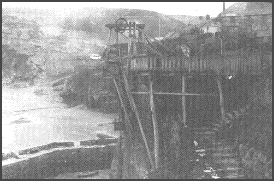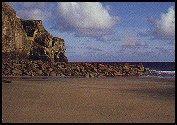
The Trevaunance Trail is a sparkling Cornish tale of high drama
- the rise and fall of the Manor of Trevaunance and the Tonkin family,
a story of tin and copper mining, seafaring folklore and five harbours.
Once a thriving port serving a mining community with a much larger population than today's, Trevaunance Cove is home to the Blue Peter IV Inshore Lifeboat and Britain's third oldest Surf Lifesaving Club. St. Agnes has always been associated with tin mining, prehistoric evidence shows early miners worked mineral outcrops in the surrounding cliffs and high ground. Many of the coastal 'caves' are in fact man made and the cliff tops are criss-crossed with the work of generations of miners. Wheal Luna is an example of an early 'open' tin working. The unusual geology of the cliffs at Trevaunance is of national importance and is protected as a Site of Special Scientific Interest.
From ancient times the Tonkin family exploited the mining wealth of the area and they were rewarded over the generations, developing the Manor of Trevaunance. Said to have contained over 100 rooms including its own Chapel, the house had a large woodland and deer park but did not survive the Tonkin family and fell into ruins with their demise. Today it is a more modest residence - a shadow of its former splendour.

Mining brought a need for raw materials and opportunities for trade with Ireland and Wales to Trevaunance. Beaching ships on the open shore in the Cove was a risky business which the Tonkin family sought to improve by building a harbour. The first three efforts in 1632, 1684 and 1699 were all quickly washed away but by 1710 a quay was successfully built. With over £6,000 spent on the harbour experiments and other debts the family were forced to relinquish their estate in 1719. The harbour survived until 1730 when it was again lost to the sea.
Sixty years on, the arrival of steam power and a copper mining boom, meant ships bringing coal from Wales and returning with ore needed a landing site and a new harbour was constructed by 1798. A counter quay was added in the 1830's and enabled fishing and sea borne trade to develop. The harbour stood for 118 years when the lack of a timely repair meant it was washed away after the winter of 1915. The huge granite blocks remain strewn at the base of the cliff to this day.

Between 1873 and 1877 four schooners were built on St. Agnes beach: the 'St. Agnes' (58 tons), the 'Goonlaze' (85 tons), the 'Trevellas' (128 tons) and the 'Lady Agnes' (91 tons). Only the 'Trevellas' was too large to work out of the harbour at Trevaunance, both the 'Trevellas' and 'Lady Agnes' were ocean going vessels and sailed to various parts of Europe and America. By 1930 all except the 'Lady Agnes' were lost and she was broken up in 1948 at Portmadoc. Her figure head was bought and sold a number of times, most recently in London by an unknown buyer in 1989.
Above Reppers Coombe you come across two abandoned water wheel pits.These are relics of terraces of tin dressing floors which refined tin ore from local mines and beach sand from Trevaunance Cove. The Reppers Coombe works were named after the Repper family who worked here until the 1950's. Tin bearing rock was crushed to sand in 'stamps' and then passed through washing processes where the heavier tin bearing sand grains became separated from the lighter material to form a 'black tin' concentrate. This was sent to the smelter to form tin ingots. All the St. Agnes mines relied on such treatment works and in the neighbouring valley of Trevellas, to the east, a set of stamps last used in the 1960's survives. Recently restored and occasionally put to use these can be seen from the footpath running up the Trevellas valley.
The pools of Trevaunance are home to an array of fascinating creatures, including the rare Cornish Sucker often found clinging to the undersides of boulders.
Cowries are normally associated with tropical waters but the small blue/white European cowry can be found feeding amongst the rocks of Trevaunance on very low tides.
Bragging of the prowess of St. Agnes fisherman, one of Cornwall's oldest folk songs was recorded from Captain Noel Carter by Thomas Tonkin in 1698. Sadly no tune survives for this Cornish language tale of the "Goon Glaze" the poetic name for the "blue green down" or sea. It survives as a place name today, Goonlaze.
A mi Moaz, a mi moaz in Goon Glaze
Mi a Clowaz, a Clowaz, a Clowaz a troz, a troz, a troz an Pysgaz miniz
Bez mi a trouviaz un Pysg brawze naw losia
Olla Boble in Porthia ha Marazjowan ne mi or dho gan zingy.
Roughly translated this means:
As I was going on the blue green down,
I heard the sound of a school of little fishes breaking the surface:
but I found one great fish with nine tails
All the people in St. Ives and Marazion could never keep hold of it.
Walks from 30 minutes to two hours are possible based in and around Trevaunance Cove. A leaflet highlighting these walks and points of interest on the way is available at many outlets in the area.
Blue Hills Tin Streams St. Agnes Walks and Walking in Cornwall